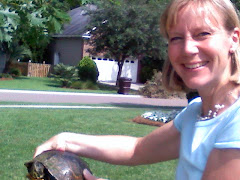- We requested our flooring company remove the old 1970s carpet and pad and recycle it at Southeast Plastics Recovery in North Charleston.
- With the carpet up, we were thrilled that the original hardwood floors were in reasonably good condition. They are 12' long, red oak boards that had never been sanded before. We refinished the floors with BONA products. These products are certified by the Greenguard Institute for Indoor Air Quality. You can search for GREENGUARD-certified products at http://www.greenguard.org
- Carpeted the upstairs with carpet made from corn plant fibers (the part that's left after they harvest the corn we eat). Reviews say it's durable and more stain resistant than some conventional carpets. It's a treat to have carpet after only having tile floors for three years.
- Painted with no-VOC paint. VOCs are volatile organic compounds that aren't good for us or the environment during their production or use. I painted almost every night after work and wasn't overcome with the usual vapors.
- Cabinetry certified by the Kitchen Cabinet Manufacturer's Association Environmental Stewardship Program - employing environmentally responsible materials and practices.
- Quartz countertops - manufactured locally, selected for their durability, and also GREENGUARD Certified for indoor air quality.
- Fluorescent lighting in most of the house. The military won't move light bulbs so we had to replace all of them anyway. We opted for LED undercabinet lighting and solar walkway lights. We installed insulated can lights in the kitchen, but they require further sealing to prevent air leakage with the attic above. In retrospect, I would have skipped the cans as the two pendants and undercabinet lights are sufficient.
- Waterwise water efficient shower heads in baths (available at your local home store and easily installed). The house came with full force faucets, and our first water bill was pretty high. I'm looking at dual flush/low flow toilets or adding a water displacement bladder in our existing toilets to decrease their water usage. (see Dwellsmart: http://www.dwellsmart.com/Products/Bathroom/Toilet-Tummy) In addition, our clothes washer was kaput after three years in storage. We replaced it with an Energy Star-rated washer that also minimizes water usage.
- I haven't had much time to work on the garden, but we added a rain barrel to capture runoff from the rear roof to water the garden and a composter to make better soil for the garden and yard. We have very sandy soil that doesn't hold water. Addition of organics will allow me to grow plants and grass while minimizing runoff from the site.
- Contractors may not be into recycling construction waste. Our remodeling contractor rented a dumpster that was emptied twice during the kitchen remodel project. We held out all metal and took it to Bees Ferry for recycling, but the rest went to the construction debris dump. I learned afterward that Habitat for Humanity has a group that will deconstruct and recycle building materials
- Really look at your lighting needs before agreeing to too much. Our house has ample natural light and we overdid it with the lighting in the kitchen. We don't need the extra lights, and it was a waste to install them. Don't let contractors upsell you!
- It takes time and commitment to research green materials. There are many options available and there are always tradeoffs.
- This is a lot of work, but very satisfying. We won't garner an LEED certification when we're done, but we will have a durable, healthy home in a great location to enjoy for years to come.
Next Up: Improving energy efficiency -- tackling our leaky ductwork attached to oversized heating/cooling systems. The house has enough heating/cooling capacity for about 3000 square feet of living space, about 50% more than we need. If we insulate and air seal the building envelope and fix the leaking ductwork, we run the risk of causing a mold issue. We're working with the Sustainability Institute and a certified home energy rater on options. Energy improvements are less "sexy" than kitchen remodels but managing moisture and humidity in the house will ensure it lasts for years to come.





No comments:
Post a Comment